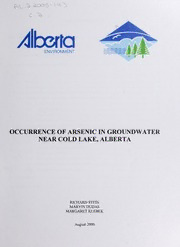
Occurrence of arsenic in groundwater near Cold Lake, Alberta PDF
Preview Occurrence of arsenic in groundwater near Cold Lake, Alberta
ydlbcrra ENVIRONMENT I I I OCCURRENCE OF ARSENIC IN GROUNDWATER NEAR COLD LAKE, ALBERTA RICHARD STEIN MARVIN DUD AS MARGARET KLEBEK August 2000 TABLE OF CONTENTS EXECUTIVE SUMMARY ii 1. INTRODUCTION 1 2. DESCRIPTION OF THE STUDY AREA 3 3. METHODOLOGY AND SAMPLING 4 4. RESULTS 5 4.1 Geology 5 4.2 Hydrogeology 9 4.3 Groundwater Flow within the Sand River Formation 9 4.4 GROLfNDWATER FLOW PATTERNS DERIVED FROM CROSS-SECTIONS 1 1 4.4. 1 Cross-Section A-A' 1 1 4.4.2 Cross-Section B-B' 15 4.4.3 Cross-Section C-C 18 4.4.4 Cross-Section D-D' 1 8 4.5 Occurrence of Arsenic within the Groundwater Flow Regime 22 4.6 Arsenic Gradients within Formations Extending From the Northern Uplands TO THE Beaver Lowlands 25 4.7 Geochemistry of Groundwater 26 4.7. 1 Arsenic, Well Depth and Casing Type 26 4.7.2 Chloride and Well Depth 28 4.7.3 Chloride and Total Organic Carbon (TOC) 29 4.7.4 Arsenic and Total Organic Carbon (TOC) 29 4.7.5 Arsenic, Iron and Redox Potential 33 5. DISCUSSION 38 REFERENCES CITED 41 Digitized by the Internet Archive in 2015 https://archive.org/details/occurrenceofarseOOstei EXECUTIVE SUMMARY There are several areas in Alberta where well water samples contain elevated and undesirable levels of dissolved arsenic. One such area is the Cold Lake region. A well water testing program conducted by Alberta Health and Wellness in 1999 showed several samples from shallow domestic wells on properties located near Crane Lake and Hilda Lake west of Cold Lake contained concentrations of arsenic that exceeded 25 |xg As/L. Such high concentrations in shallow wells (less than 35 m deep) appeared unusual based on data from province wide testing programs. Alberta Environment commissioned a study to better understand the hydrogeology of the area and the geochemical characteristics of groundwater in order to elucidate conditions that may account for the observed high levels of arsenic. The study area is located about 32 km west of Cold Lake and centered in the Beaver Lowlands which contain Crane, Edward, Ethel, Harold, Hilda, and Maloney lakes. The local geology and hydrology were summarized using published information and lithologic and borehole geophysical data from water well logs from Alberta Environment records. Field measurements and water sampling were conducted in January and February 2000 in conjunction with the Alberta Health and Wellness monitoring program. The geology of the area consists of marine shale bedrock belonging to the Lea Park Formation overlain by the Empress Formation Unit 3, the Muriel Lake Formation, sand within the Bonnyville Formation, Ethel Lake Formation and the Sand River Formation (listed from oldest to youngest, respectively). These formations constitute the aquifers of the study area. Flow in most of these formations is generally from north to south but with upward and downward components to groundwater flow. The shallow wells, which are the focus of this study, occur in the Sand River Formation. Results of this study showed that there were no systematic arsenic gradients from north to south in the various aquifers for those areas where adequate data was available. In the area of shallow wells in the Sand River Formation with high arsenic levels, groundwater flow is characterized by ii lateral, downward and upward components. For these shallow wells, our study showed the following: • Well casing type does not account for the elevated levels of arsenic • The arsenic in shallow wells is of local origin and not from underlying aquifers • Low redox conditions are related to high arsenic concentrations • Waters high in arsenic are also high in dissolved iron • Redox values are sufficiently low that secondary iron oxide minerals dissolve, thereby releasing adsorbed arsenic to groundwater Our study concludes that arsenic in the shallow wells of the study area originates from the dissolution of iron oxides brought about by the low redox conditions in these shallow wells. The cause of the low redox conditions was not identified in this study. iii 1. INTRODUCTION Early results (February to July of 1999) from the year-long monthly water sampling program conducted by Alberta Health and Wellness (AHW) in an area west of Cold Lake, Alberta, showed that arsenic dissolved in those waters ranged in concentration from less than one to 73 migrograms per litre (|ig/L). While concentrations in this range were not unexpected in view of previous surveys conducted in the area (Stanley Associates Engineering Ltd., 1979; Canada- Alberta Environmentally Sustainable Agriculture Agreement, 1987; Imperial Oil Resources and Komex International Ltd., 1998; and Nriagu, J.O., 1998), a number of values (greater than 15 |ig/L) occurred in water from wells that are relatively shallow (less than 35 m deep). Previous data and current AHW survey data show that the deeper* wells generally tend to have the higher arsenic levels. A second notable feature about the elevated arsenic concentrations in shallow water wells was the spatial distribution of the wells. They occur primarily in an area as much as six kilometres (km) south of Crane Lake and within one km south of Hilda Lake (Figure 1). Additionally, it is well knovm that arsenic is a naturally occurring element in the glacial deposits and bedrock sediments of the Cold Lake area (Andriashek, 2000). Andriashek found arsenic concentrations in the silt and clay fractions of till, clay, and shale sampled from five auger holes to range from five to 12 mg/kg for clay and till, and 10 to 20 mg/kg for bedrock shale. These values indicate that abundant arsenic is available for dissolution from the naturally occurring rock units of the area, especially the bedrock shale, and to a lesser degree from the till and clay units which are in large part derived from the shale. Throughout this report reference will be made to shallow and deep wells. Shallow wells refers to those completed at a depth of less than 35 m, whereas deep wells are those completed at a depth of more than 35 m. 1
